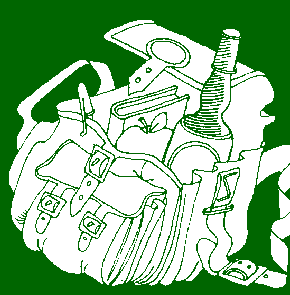 In February 1996, the Society ran
the first of its 'Whisky Schools'. Charles MacLean records his
impressions.
In February 1996, the Society ran
the first of its 'Whisky Schools'. Charles MacLean records his
impressions.
The delegates began to trickle into the Members Room shortly after nine on a Sunday morning. A chemist from Germany; a whisky expert from Holland; a student from Edinburgh; two members from Cheshire; the owner of a whisky shop in Inveraray; the editor of Scotland's leading business magazine... Nine of us in all, gulping coffee, mumbling introductions, in my case clearing a thick head from last night on the town.
Our hosts and mentors - Jim Swan and Trevor Cowan - were relaxed and confident. This was the second day of the schools; yesterday's session had been a great success. There was a keen air of anticipation about today's programme. Which began with a simple odour recognition test: eight pots filled with cotton wool saturated with substances as diverse as malt vinegar and treacle toffee, lavendar and ginger oil. The purpose was as much to identify any 'odour blindness' in our nosing ability as to name the scents. Everyone scored over 75% (the pass rate for blenders is 70%).
Then into the Tasting Room. Trevor Cowan, former Master Blender with Invergordon, warmed us up with some statistics about Scotch's performance in world markets, then Dr. Jim Swan - the leading sensory chemist who was profiled in the Christmas issue of this publication - introduced us to the physiology of sensory perception: how we smell and taste, what we can smell and taste, the chemical compounds which hold aromas and flavours together, and how sensitive these are to dilution [one up for cask strength whiskies!].
After coffee we launched into production, and the contribution made by the simple ingredients from which malt whisky is made - water, barley, peat, yeast. We learned how the role of water has been exagerated; the secrets of milling and mashing; the mysteries of fermentation (I had no idea that there are two, the second, biological, one is crucial to the flavour of good malt); what happens during distillation. Macallan had given the Society samples of new spirit, drawn off at twenty minute intervals, and it was remarkable how you could smell quite clearly when the various flavour groups - esters, aldehydes, feints - came in or declined or vanished. Such is the quality of Macallan new-make, and so narrow their cut, that the still-man had to draw his final samples a good hour after he had stopped saving spirit, in order to present us with something which was truly feinty!
Then we broke for lunch - a proper, sit-down affair, with delicious and unusual dishes, prepared by the Society's Master Chef, Angela Jaques.
The afternoon session was opened by Dr Harry Rifkin, Jim Swan's partner in R.R.Tatlock & Thomson (Analytical Chemists). His subject was pot still distillation - the different styles of spirit produced by different shaped stills, the science of distillation, the importance of copper and the craft of the still-man. He did not shirk the chemistry - this was authoritative stuff, not the kind of information you can get from books - delivered at break-neck pace.
The experts reckoned that about half the ultimate quality of a whisky derives from the quality of the new-make spirit. The other half comes from maturation, and after tea, Jim Swan took the head of the table again to consider the mysteries of wood, warehouse and micro-climate. He is arguably the world expert on this subject and his talk was enlivened with first-hand experiences and discoveries, supported by his own slides of forests in Central Europe and America and elucidated by samples of mature spirit from various distilleries.
During the hour before dinner Trevor Cowan conducted us through the history of the whisky trade: full of revelation and curious anecdote - as only someone who has spent their whole life in the trade could have delivered it - and supported by many unusual samples of fine malt whisky. Discussion and anecdote continued over the four-course dinner which Angela served to us in the Members' Room, and we tottered to our taxis about 10.00 p.m.
With this article in mind, I lobbied the views of some of the delegates on the Whisky School. One summed it up perfectly when he said: "Not since I ran into George Mellie in Bannerman's Bar, have I spent such an engaging, informative and stimulating day."
Charles MacLean
Unless otherwise noted, all information in this site © The Scotch Malt Whisky Society, Edinburgh, Scotland, 1997.